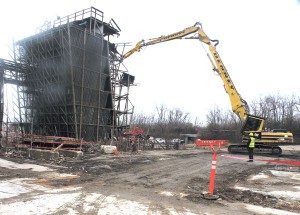A great deal of attention has been paid to the site on the corner of Michigan and Sherman in the past couple of weeks — attention from the city, as well as the near east side community that has waited for many years for something to be done about the eyesore that used to be a thriving RCA plant that stamped out records and supported thousands of workers in its heyday.
The city held a press conference on January 23 announcing the demolition of the remaining structures on the site. Mayor Joe Hogsett noted that it was a “celebration of the first steps to knocking out crime and environmental concerns” on the site, to hopefully make way for greater opportunity. He noted that the property has sat vacant, attracting crime, vandalism, and other illegal activity, contributing to problems in the neighborhoods around it. Chief of Police Bryan Roach, City-County Councillor Blake Johnson, Near Eastside Asset Redevelopment leader John Franklin Hay, and Department of Metropolitan Development leader Emily Mack echoed the mayor’s sentiments.
In addition, the mayor announced that NEAR had received an Area-Wide Planning Grant of $200,000 from the EPA that will lead an 18-24 month public discussion in the community to explore reuse opportunities and challenges at the property, which has been renamed Sherman Park.

Ethel Winslow/Weekly View
The former RCA plant is contaminated with chemicals, and since its abandonment, has attracted crime, illegal dumping, and become a hazard to the community.
The demolition comes on the heels of community meetings on January 11and January 21 on the possibility of the site being redeveloped as a Community Justice Center. The city’s Criminal Justice Task Force announced earlier this year that the city had narrowed the site search down to three: the former Citizens Gas coke plant in the Twin-Aire neighborhood on the southeast side, the old airport on the far west side, and Sherman Park. The January 11 meeting involved the city’s proposal to build a 3,000 bed jail, plus an assessment center for non-violent low level offenders who would be guided to mental health and addiction services rather than jail. The city also mentioned that they would like to relocate the courts, but the decision to move the courts was up to judges. There was a lively discussion of the pros and cons of the potential development, and it was determined that another meeting would need to be held to further discuss the plans before the neighborhood could tell the city whether or not they would welcome the center.
On January 21, neighborhood leaders, members of the community, and city representative met again to discuss concerns about the proposed Justice Center. In breakout sessions, questions about the feasibility of the project, environmental concerns, issues about crime and traffic, and much more were discussed. Many residents were concerned that there were no specific plans, and a lot of “ifs” regarding the project. Some stated that they hoped that commercial or light industrial development might be in the future. Others supported the project, stating that commercial or light industrial development was unlikely at the site given the contamination and other factors on the property. At the end of the meeting, a vote was taken as to whether residents wanted to the development at Sherman Park. Because the meeting fell under the emergency meeting rules, a 75 percent vote was needed for approval or disapproval. Of the 70 residents in attendance, 51 voted “yes” and 19 voted “no” — one vote shy of approval.
Nevertheless, the EPA planning grant will allow residents a wide window of opportunity to meet and discuss future development, and to address the clean-up of the property, which is a brownfield.



